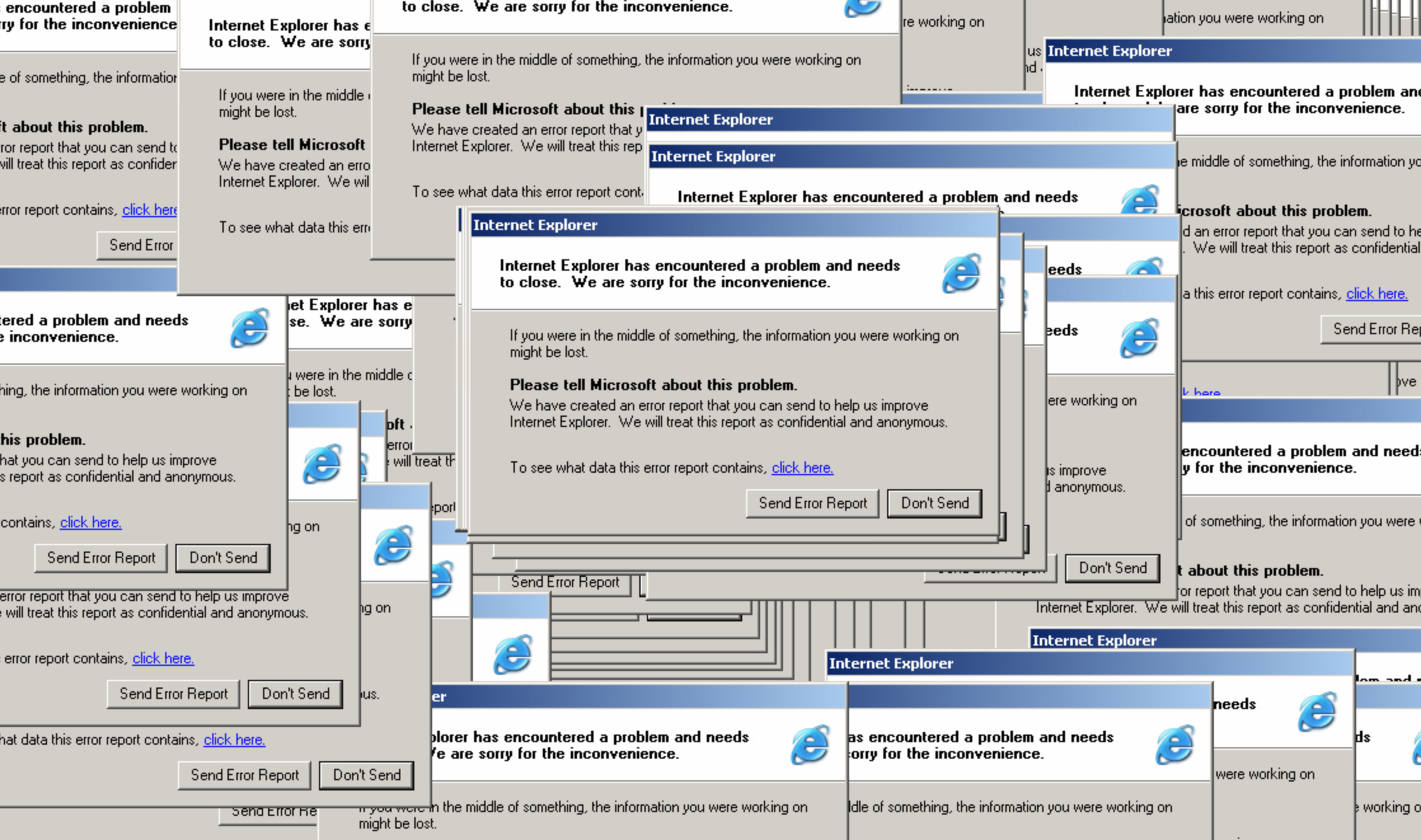React Promise Modal

專案中很常出現按鈕點下跳出 “確認視窗” 的行為,有時候是刪除的警告確認、有時候是資料送出的確認。這些有共同操作行為的 Component 都應該做成共用的元件以方便在各種情況下重複使用, 才不會某 A 做一個版本,某 B 做另一個版本,大家都自己寫自己的造成維護上的困難。
此文章不會詳細列出各項程式碼,如果有興趣可以 clone source code 下來研究研究。
封面圖來源:https://mrdoob.com/lab/javascript/effects/ie6/
期望可以用以下程式碼達到我要的目的:
import React from 'react'
import { confirmBox } from './promiseModal'
class App extends React.Component {
render() {
<button
onClick={() => {
confirmBox({
title: 'Logout',
description: 'Are you sure to logout?',
}).then(() => {
console.log('Confirm, Do some logout action...')
}).catch(() => {
console.log('Cancel, Nothing happened...')
})
}}
>
Logout
</button>
}
}
confirmbox 執行並帶入客製化 params,期望最後會回傳 promise 物件,並由 .then() 或是 .catch() 來知道使用者點下 Confirm 還是 Cancel 再做後續的動作。
實作步驟分析
準備一個基本的 popup modal component(確認視窗)。
因為 modal 是一個蓋版視窗,使用者必須要按下
Confirm或Cancel按鈕才能繼續操作,所以選擇使用Promise物件來等待使用者按下按鈕。執行
confirmBox的時候,預期會 create 一個promise物件,並在裡面將 React Component 掛載到某個 div 上面(ReactDOM.render),並將resolve、rejectfunction 當作 props 一併傳到 modal 中使用。因為 modal 擁有了
resolve、reject這兩個可以繼續promise的 function,所以可以在按下Confirm按鈕的時候呼叫resolve,按下Cancel按鈕的時候呼叫reject來達成Promise Chain的目的。無論按下哪一個按鈕後都應該要清除、卸載,動態掛上去的 React Component。
以下解說都會省略 css code, 有興趣可以看 source code
Step 0. 準備範例按鈕
class App extends Component {
render() {
return (
<div className="App">
<button
type='button'
className='btn-example logout'
>
Logout
</button>
<button
type='button'
className='btn-example submit'
>
Submit
</button>
<button
type='button'
className='btn-example delete'
>
Destroy
</button>
</div>
);
}
}

Step 1. 準備基本 popup modal
使用 react-modal 來快速建造一個確認視窗的 modal。
import React, { useState } from 'react'
import PropTypes from 'prop-types'
import Modal from 'react-modal'
const ConfirmBox = (props) => {
const {
color, // 客製化顏色
title, // 客製化文字
description, // 客製化文字
onConfirm, // 預期收到 resolve function
onCancel, // 預期收到 reject function
confirmText, // 客製化文字
cancelText, // 客製化文字
} = props
// `useState` 是 react 16.8 新功能 hooks, 等同於 state/setState 效果
// 初始值為 true
const [isOpen, setIsOpen] = useState(true)
const onClickConfirm = () => {
// 按下 Confirm 將 modal 關閉, 並執行 onConfirm (resolve function)
setIsOpen(false)
onConfirm()
}
const onClickCancel = () => {
// 按下 Confirm 將 modal 關閉, 並執行 onCancel (reject function)
setIsOpen(false)
onCancel()
}
return (
<Modal
overlayClassName='promise-modal-overlay'
className='confirm-box'
isOpen={isOpen}
onRequestClose={onClickCancel} // 點下 modal 之外的區域時觸發 (modal overlay)
shouldReturnFocusAfterClose={false}
>
<div className={`modal-container color-${color}`}>
<div className='modal-header'>
<h3>{ title }</h3>
<button
type='button'
className='close-btn'
onClick={onClickCancel}
>
X
</button>
</div>
<div className='modal-content'>
<p>{ description }</p>
<div className='button-list'>
<button
type='button'
className='cancel'
onClick={onClickCancel}
>
{ cancelText }
</button>
<button
type='button'
className='confirm'
onClick={() => onClickConfirm()}
>
{ confirmText }
</button>
</div>
</div>
</div>
</Modal>
)
}
測試一下剛剛做的 Component Render 有沒有正確,丟到測試頁面看看 js/css 有沒有正確。

Step 2. 製作 Promise function
流程可以拆分為以下:
- 動態產生不重複的 div element,為了讓
ReactDom.render掛載上去。 - new 一個
Promise物件,並在第一個 promise 裡面將Modal Component掛載上去。 - 成功 render React Modal 之後就會在介面上看到蓋版 Modal,並等待使用者按下按鈕之後接續呼叫
resolve、rejectfunction。 - 卸載、移除先前動態產生的 Component、Element。
import React from 'react'
import ReactDOM from 'react-dom'
import Modal from 'react-modal'
// 卸載、移除先前動態產生的 Component、Element
const unsetPromiseModal = (wrapper) => {
setTimeout(() => {
ReactDOM.unmountComponentAtNode(wrapper)
wrapper.remove()
}, 300)
}
// 動態產生不重複的 div element
const findOrCreateWrapper = (identifyID) => {
let wrapper = document.getElementById(identifyID)
if (wrapper === null) {
wrapper = document.body.appendChild(document.createElement('div'))
wrapper.id = identifyID
}
return wrapper
}
// params 預期接收要被掛載的 Component, 跟客製化 options
const promisableModal = (Component, options = {}) => {
// 動態產生不重複的 div element
const wrapper = findOrCreateWrapper(`promise-modal-wrapper-${Date.now()}`)
// 無障礙網頁辨識用, 參考:http://reactcommunity.org/react-modal/accessibility/#
Modal.setAppElement(wrapper)
const promise = new Promise((resolve, reject) => {
ReactDOM.render( // 掛載 React Component
<Component
{...options} // 帶入客製化參數(props)
onConfirm={resolve} // resolve 傳給 onConfirm
onCancel={reject} // reject 傳給 onCancel
/>,
wrapper,
)
})
return promise.then(() => {
// 使用者按下 Confirm 之後執行此段
unsetPromiseModal(wrapper)
return true
}, () => {
// 使用者按下 Cancel 之後執行此段
unsetPromiseModal(wrapper)
return Promise.reject(false)
})
}
export default promisableModal
由於最後回傳的是一個 promise 物件,如果接續著呼叫 .then() 會在使用者按下 Confirm 後接續執行;如果接續著呼叫 .catch() 會在使用者按下 Cancel 後接續執行。
Step 3. 組合
import './style.scss' // base modal overlay csss
import promisableModal from './promisableModal'
import ConfirmBox from './components/ConfirmBox'
// 將 ConfirmBox 和 promisableModal 做組合
const confirmBox = props => promisableModal(ConfirmBox, props)
export {
promisableModal,
confirmBox,
}
因為已經寫好了可以 promisable 的 function,所以未來如果想要擴充其他種類型的 modal,都可以透過 promisable 輸出,例如未來我如果想做一個編輯蓋版視窗:
... 省略
import EditBox from './components/EditBox'
const editBox = props => promisableModal(EditBox, props)
export {
promisableModal,
confirmBox,
editBox, // 新的擴充
}
Step 4. 使用
三種不同情境的確認視窗,都只要呼叫同一個 promise function 來達成目的,達到 reuse 的目的。
import React, { Component } from 'react'
import './App.scss'
import { confirmBox } from './promiseModal'
class App extends Component {
render() {
return (
<div className="App">
<button
type='button'
className='btn-example logout'
onClick={() => {
confirmBox({
color: 'primary',
title: 'Logout',
description: 'Are you sure to logout?',
}).then(() => {
console.log('%c Click Confirm!, prepare to logout ...', 'color: blue')
}).catch(() => {
console.log('%c Click Cancel!, nothing happened ...', 'color: blue')
})
}}
>
Logout
</button>
<button
type='button'
className='btn-example submit'
onClick={() => {
confirmBox({
color: 'info',
title: 'Submit Form',
description: 'Are you sure to submit form?',
confirmText: 'Submit',
}).then(() => {
console.log('%c Click Confirm!, prepare to fetch data to backend api ...', 'color: green')
}).catch(() => {
console.log('%c Click Cancel!, nothing happened ...', 'color: green')
})
}}
>
Submit
</button>
<button
type='button'
className='btn-example delete'
onClick={() => {
confirmBox({
color: 'danger',
title: 'Delete Product',
description: 'Are you sure to delete this product?',
confirmText: 'Delete',
}).then(() => {
console.log('%c Click Confirm!, prepare to fetch data to delete product ...', 'color: red')
}).catch(() => {
console.log('%c Click Cancel!, nothing happened ...', 'color: red')
})
}}
>
Destroy
</button>
</div>
);
}
}

Don’t Repeat Yourself,這個範例的元件在我先前的幾份專案中都有用到,而且都只是複製最初的那一份出來調整 css 而已。
寫 React 的時候不妨思考一下專案中哪些是常常共用的元件,試著練習抽離出來做成 shared component,會省下未來不少時間。